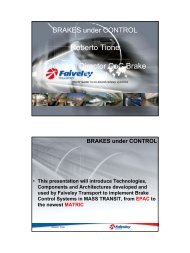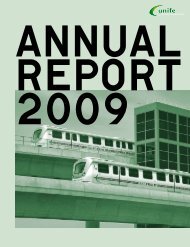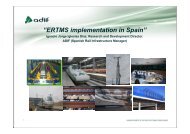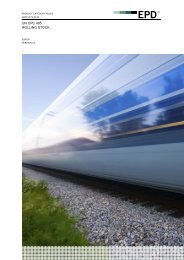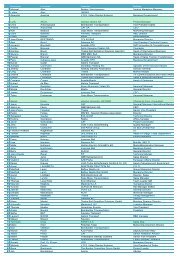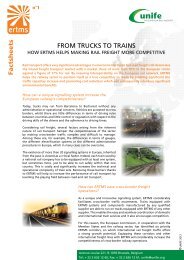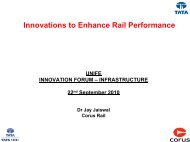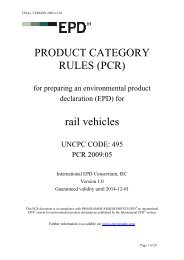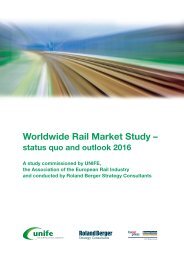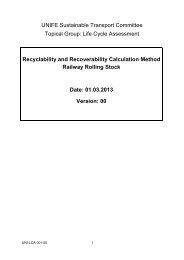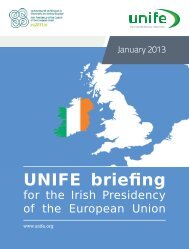UIC and the development of worldwide railway standards - Unife
UIC and the development of worldwide railway standards - Unife
UIC and the development of worldwide railway standards - Unife
You also want an ePaper? Increase the reach of your titles
YUMPU automatically turns print PDFs into web optimized ePapers that Google loves.
International St<strong>and</strong>ards<br />
16 April 2012<br />
Emilio Maestrini , Director Rail System<br />
Department
Contents<br />
1. The Reasons for St<strong>and</strong>ardisation<br />
Fundamental Values<br />
Characteristics<br />
Context<br />
Challenges<br />
2. Railway St<strong>and</strong>ardisation<br />
Stakeholders’ Families<br />
Stakeholders’ Roles<br />
<strong>UIC</strong> Leaflets Development<br />
3. <strong>UIC</strong> St<strong>and</strong>ardisation<br />
Specification Space<br />
Activity<br />
Guidelines <strong>and</strong> Products<br />
394 <strong>UIC</strong> Leaflets in <strong>the</strong> Rail System Forum<br />
4. <strong>UIC</strong> Agreements CEN/CNL Agreement , Revision <strong>and</strong> ISO proposal<br />
MOU <strong>Unife</strong> for Tec Rec<br />
MOU ERA <strong>and</strong> ECC for applications TSI<br />
2 A Path towards St<strong>and</strong>ardisation/16 April 2012
The Reason for St<strong>and</strong>ardisation<br />
for <strong>the</strong> market<br />
St<strong>and</strong>ardisation facilitates <strong>the</strong> free movement <strong>of</strong> people <strong>and</strong> goods.<br />
Services<br />
Network Interoperability<br />
Means <strong>of</strong> Communication<br />
Technological Development<br />
Innovation<br />
are <strong>the</strong> items that pivot around<br />
St<strong>and</strong>ardisation.<br />
St<strong>and</strong>ards<br />
increase <strong>the</strong> competition,<br />
lower output <strong>and</strong> sales<br />
costs,<br />
benefiting economy as a<br />
whole <strong>and</strong> consumers in<br />
St<strong>and</strong>ards produce significant<br />
particular.<br />
positive economic effects, for<br />
example by promoting<br />
economic<br />
interpenetration on <strong>the</strong><br />
internal market <strong>and</strong> encouraging<br />
<strong>the</strong> <strong>development</strong> <strong>of</strong> new<br />
<strong>and</strong> improved products or<br />
markets <strong>and</strong> improved supply<br />
conditions.<br />
St<strong>and</strong>ards may<br />
3 A Path towards St<strong>and</strong>ardisation/16 April 2012<br />
- maintain <strong>and</strong> enhance<br />
quality<br />
- provide information<br />
- ensure interoperability<br />
<strong>and</strong> compatibility,<br />
- increase safety <strong>and</strong><br />
value for consumers.
The Reasons for St<strong>and</strong>ardisation<br />
Characteristics<br />
The St<strong>and</strong>ardisation System should be a voluntary<br />
system, organised under principles such as<br />
• transparency<br />
• openness<br />
• impartiality<br />
• consensus<br />
• maintenance<br />
• availability<br />
• quality<br />
• stability<br />
• effectiveness<br />
• independence <strong>of</strong> specific interests<br />
• market relevance<br />
• coherence<br />
4 A Path towards St<strong>and</strong>ardisation/16 April 2012
The Reason for St<strong>and</strong>ardisation<br />
Context<br />
.........<br />
5 A Path towards St<strong>and</strong>ardisation/16 April 2012
The Reason for St<strong>and</strong>ardisation<br />
Challenges<br />
St<strong>and</strong>ards help in <strong>the</strong> major societal challenges<br />
globalisation<br />
economic <strong>and</strong> financial crisis<br />
innovation<br />
market weaknesses<br />
climate change<br />
sustainable resource use<br />
ageing <strong>of</strong> population<br />
integration <strong>of</strong> people with disabilities<br />
consumer protection<br />
It is necessary to ensure that <strong>the</strong> role<br />
<strong>and</strong> <strong>the</strong> input <strong>of</strong> public <strong>and</strong> societal<br />
stakeholders in <strong>the</strong> elaboration <strong>of</strong><br />
st<strong>and</strong>ards are streng<strong>the</strong>ned.<br />
workers’ safety <strong>and</strong> conditions<br />
social inclusion<br />
6 A Path towards St<strong>and</strong>ardisation/16 April 2012
Railway St<strong>and</strong>ardisation<br />
Stakeholders’ Families<br />
Right Roles in <strong>the</strong> field <strong>of</strong> Railway St<strong>and</strong>ardisation<br />
Stakeholders:<br />
• Operators (Railway Undertak. & Infra. Manag.)<br />
• Manufacturers<br />
• St<strong>and</strong>ardisation Bodies (NSB,Cen/Cnl…)<br />
Service - Market - Essential Prerogatives <strong>of</strong><br />
Railway<br />
+<br />
(Multiform Geographical Reality)<br />
+<br />
(Specific Interests)<br />
7 A Path towards St<strong>and</strong>ardisation/16 April 2012
Railway St<strong>and</strong>ardisation<br />
Stakeholders’ Roles<br />
Reestablish <strong>the</strong> ROLES <strong>of</strong> <strong>the</strong><br />
different Stakeholders<br />
The focal point <strong>of</strong> Operators Transports shall be <strong>the</strong> Service to <strong>the</strong><br />
Market.<br />
The role <strong>of</strong> <strong>the</strong> industry is to supply <strong>the</strong> instrumental tools by which <strong>the</strong> RUs (Railway<br />
Undertakings) & IMs (Infrastructure Managers) supply <strong>the</strong> services. They are involved<br />
in <strong>the</strong> Quality process .<br />
The NSBs (National Safety Bodies) have a role <strong>of</strong> definition, verification <strong>and</strong> control <strong>of</strong><br />
<strong>the</strong> requirements which shall enhance safety.<br />
The V&V process (Validation & Verification) is based on <strong>the</strong> St<strong>and</strong>ard applied by NoBo<br />
(Notified Bodies), thus St<strong>and</strong>ards are a value for safety .<br />
8 A Path towards St<strong>and</strong>ardisation/16 April 2012
Railway St<strong>and</strong>ardisation<br />
<strong>UIC</strong> Leaflets Development<br />
How?<br />
Determine a STEP CHANGE in <strong>the</strong> Railway Transport:<br />
‣ to unify processes <strong>and</strong> instrumental tools to answer to <strong>the</strong> new safety<br />
requirements<br />
‣ to define <strong>the</strong> minim level <strong>of</strong> quality <strong>of</strong> <strong>the</strong> services<br />
‣ to analyse <strong>the</strong> sustainability to get <strong>the</strong> necessary resources<br />
What?<br />
Unify pre-competitive functionalities <strong>and</strong> <strong>the</strong>ir measurement through RAMS<br />
parameters (Reliability, Availability, Maintainability <strong>and</strong> Safety) <strong>and</strong> LCC (Life Cycle<br />
Cost).<br />
St<strong>and</strong>ardisation arrives to <strong>the</strong> processes <strong>and</strong>, at last, to <strong>the</strong> measurability indexes (Key<br />
Performance Indicator - KPI) on which to build <strong>the</strong> business cases ( Asset<br />
Management) <strong>and</strong> consequently <strong>of</strong>fer products in a competitive manner.<br />
9 A Path towards St<strong>and</strong>ardisation/16 April 2012
<strong>UIC</strong> St<strong>and</strong>ardisation<br />
Specification Space<br />
= LCC<br />
P = Requiments<br />
= RAMS<br />
= Functionalities<br />
10 A Path towards St<strong>and</strong>ardisation/16 April 2012
<strong>UIC</strong> St<strong>and</strong>ardisation<br />
Activity<br />
1. Need <strong>of</strong> St<strong>and</strong>ardisation Activity for <strong>the</strong> new dem<strong>and</strong>s <strong>of</strong> <strong>the</strong> market .<br />
2. Definition <strong>of</strong> International Railway St<strong>and</strong>ards (IRS) specify requirements used in <strong>the</strong> whole world<br />
3. International Railway St<strong>and</strong>ards define <strong>and</strong> rely upon a description <strong>of</strong> <strong>the</strong> Railway System based<br />
on Level Systems <strong>and</strong> Subsystems mutually linked by defined Interfaces.<br />
4. Systems, Subsystems, Components <strong>and</strong> Interfaces are in <strong>the</strong> main interest <strong>of</strong> <strong>UIC</strong> Members because<br />
<strong>the</strong>y are <strong>the</strong> main entities in charge <strong>of</strong> <strong>the</strong> production <strong>of</strong> <strong>the</strong> Railway Service . The <strong>UIC</strong> G.A. asked<br />
for <strong>the</strong> creation <strong>of</strong> a Working Group , named SWG (St<strong>and</strong>ardisation Working Group) , charged to<br />
find out <strong>the</strong> most effective Leaflets that are <strong>of</strong> interest to Members.<br />
SWG<br />
St<strong>and</strong>ardisation<br />
Working<br />
Group<br />
Classify <strong>UIC</strong><br />
Leaflets for<br />
IRS<br />
Consider<br />
technology<br />
progresses<br />
Missing<br />
st<strong>and</strong>ards<br />
Answer to<br />
needs <strong>of</strong><br />
<strong>UIC</strong><br />
Members.<br />
11 A Path towards St<strong>and</strong>ardisation/16 April 2012
To ensure a modern<br />
Leaflets today .<br />
<strong>UIC</strong> St<strong>and</strong>ardisation<br />
700 <strong>UIC</strong> Leaflets <strong>of</strong> which 400 in <strong>the</strong> Rail System Forum<br />
state-<strong>of</strong>-<strong>the</strong>-art : a first step is to evaluate <strong>the</strong> <strong>development</strong> <strong>of</strong> <strong>UIC</strong><br />
Categories<br />
Work<br />
Program<br />
0 Good as <strong>the</strong>y are<br />
A Direct global importance, sometimes <strong>the</strong>y have to be updated with <strong>the</strong><br />
highest priority<br />
B Important <strong>and</strong> in need <strong>of</strong> being updated<br />
C Outdated <strong>and</strong> to be frozen<br />
D The new <strong>the</strong>mes asked by Market in <strong>the</strong> Structure <strong>of</strong> <strong>the</strong> Railway System<br />
12 A Path towards St<strong>and</strong>ardisation/16 April 2012
<strong>UIC</strong> St<strong>and</strong>ardisation<br />
394 <strong>UIC</strong> Leaflets in <strong>the</strong> Rail System Forum<br />
Leaflets Groups 0 A B C D<br />
Rolling Stock 53 3 80 136 3<br />
Train Track Interaction 8 3 6 4 0<br />
Track <strong>and</strong> Structures 30 1 20(^) 1 0<br />
Signalling & Operations 0 14 0 19 0<br />
Energy Management 0 4 9 0 0<br />
Total 91 25 115 160 3<br />
(^) Category B or C on <strong>the</strong> base <strong>of</strong> <strong>the</strong> decisions taken by <strong>the</strong> RSF Sectors<br />
13 A Path towards St<strong>and</strong>ardisation/16 April 2012
<strong>UIC</strong> St<strong>and</strong>ardisation<br />
394 <strong>UIC</strong> Leaflets in <strong>the</strong> Rail System Forum<br />
Classification <strong>of</strong> <strong>the</strong> <strong>UIC</strong> Leaflets<br />
The <strong>UIC</strong> Leaflets have been classified into 3 classes according to <strong>the</strong> goal<br />
Railway System’s Structure.<br />
<strong>of</strong> <strong>the</strong><br />
System<br />
Requirements related to Operation <strong>and</strong> Traffic Management<br />
Transverse Items<br />
Requirements to ensure safety <strong>and</strong> interoperability <strong>of</strong> <strong>the</strong> Railway System’s<br />
Components <strong>and</strong> Equipment<br />
Components<br />
Requirements <strong>of</strong> elementary items, groups <strong>of</strong> items, Subassemblies or Complete<br />
Assemblies <strong>of</strong> Equipment incorporated into a Railway Subsystem; <strong>the</strong>y generally are<br />
<strong>the</strong> minimum unity <strong>of</strong> maintenance .<br />
14 A Path towards St<strong>and</strong>ardisation/16 April 2012
<strong>UIC</strong> St<strong>and</strong>ardisation<br />
394 <strong>UIC</strong> Leaflets in <strong>the</strong> Rail System Forum<br />
Leaflets Groups Sy TI Co<br />
Rolling Stock 25 105 145<br />
Train Track Interaction 11 9 1<br />
Track <strong>and</strong> Structures 7 11 34<br />
Signalling & Operations 6 11 16<br />
Energy Management 11 1 1<br />
Total 60 137 197<br />
15 A Path towards St<strong>and</strong>ardisation/16 April 2012
Co-operation between <strong>the</strong> <strong>UIC</strong> <strong>and</strong> CENELEC <strong>and</strong><br />
between <strong>UIC</strong> <strong>and</strong> CEN<br />
> Two « Memor<strong>and</strong>um <strong>of</strong> Underst<strong>and</strong>ing » (MoU)<br />
One MoU is signed between <strong>UIC</strong> <strong>and</strong> <strong>the</strong> CEN (European Committee<br />
for St<strong>and</strong>ardisation)<br />
One MoU is signed between <strong>UIC</strong> Regional Assembly Europe <strong>and</strong> <strong>the</strong><br />
CENELEC (European Committee for Electrotechnical<br />
St<strong>and</strong>ardisation). The MoU is limited to Europe due to <strong>the</strong> Dresden<br />
agreement.<br />
> The benefits expected from <strong>the</strong> use <strong>of</strong> this agreement include:<br />
increasing transparency <strong>of</strong> work ongoing in <strong>UIC</strong> to ESB<br />
(European St<strong>and</strong>ardisation Bodies) members, <strong>and</strong> <strong>the</strong>ir<br />
possibility to influence <strong>the</strong> content <strong>of</strong> EN st<strong>and</strong>ards;<br />
avoidance <strong>of</strong> duplication <strong>of</strong> work <strong>and</strong> structures, thus<br />
allowing expertise to be focused <strong>and</strong> used in an efficient<br />
way for <strong>the</strong> benefit <strong>of</strong> international st<strong>and</strong>ardisation;<br />
16 A Path towards St<strong>and</strong>ardisation/16 April 2012
Revision agreement CEN/CNL <strong>and</strong> Proposal ISO<br />
The Memor<strong>and</strong>um <strong>of</strong> Underst<strong>and</strong>ing signed in 2005 with CEN <strong>and</strong> CENELEC<br />
needs to be revised to include new issues.<br />
<strong>UIC</strong> has <strong>of</strong>fered a huge<br />
St<strong>and</strong>ards.<br />
number <strong>of</strong> Leaflets to be converted into European<br />
We need to find a new agreement including <strong>the</strong> <strong>development</strong> <strong>of</strong> ENs <strong>and</strong> <strong>UIC</strong><br />
Leaflets <strong>and</strong> a better definition <strong>of</strong> <strong>the</strong> IP (Intellectual Property).<br />
<strong>UIC</strong> cannot be an active Member <strong>of</strong> ISO because it is not a National<br />
St<strong>and</strong>ardisation Body (NSB) . However, it already is an associated Member <strong>of</strong><br />
this Organisation .<br />
ISO has delivered a new TC (Technical Committee) for <strong>the</strong> Railway field, with<br />
<strong>the</strong> participation <strong>of</strong> NSBs.<br />
<strong>UIC</strong> <strong>of</strong>fers a “world vision” for <strong>railway</strong>s with a sole knowledge in <strong>the</strong> field, which<br />
is fully supported by Oriental Countries .<br />
The future <strong>of</strong> <strong>UIC</strong> is <strong>the</strong> st<strong>and</strong>ardisation <strong>of</strong> requirements <strong>and</strong> functions <strong>of</strong> <strong>the</strong><br />
Rail System more than st<strong>and</strong>ardisation <strong>of</strong> industrial components.<br />
For this reason <strong>UIC</strong> is looking for new agreement with CEN/CNL <strong>and</strong> ISO .<br />
17 A Path towards St<strong>and</strong>ardisation/16 April 2012
Co-operation between <strong>the</strong> <strong>UIC</strong> <strong>and</strong> UNIFE<br />
> UNIFE <strong>and</strong> <strong>UIC</strong> have agreed to work toge<strong>the</strong>r <strong>and</strong> decided to jointly<br />
publish Technical Recommendations (TecRecs).<br />
> A TecRec is a <strong>UIC</strong>/UNIFE st<strong>and</strong>ard <strong>of</strong> which, <strong>the</strong> primary field <strong>of</strong> application<br />
will be <strong>the</strong> European rolling stock domain <strong>and</strong> its interfaces with o<strong>the</strong>r<br />
subsystems, <strong>and</strong> is <strong>the</strong> preferred solution by both partners for, in<br />
particular:<br />
Product <strong>and</strong> interface st<strong>and</strong>ards such as st<strong>and</strong>ardisation <strong>of</strong><br />
component interfaces<br />
Publication <strong>of</strong> results <strong>of</strong> common research programs<br />
Acceleration <strong>and</strong> better influence over <strong>the</strong> European St<strong>and</strong>ardisation<br />
works<br />
Pending <strong>the</strong> publication <strong>of</strong> a European st<strong>and</strong>ard a TecRec will serve as a<br />
common comprehensive st<strong>and</strong>ard, approved by <strong>UIC</strong> <strong>and</strong> UNIFE to improve<br />
<strong>the</strong> competitiveness <strong>of</strong> <strong>the</strong> European <strong>railway</strong> systems.<br />
TecRecs are managed by a joint <strong>UIC</strong>/UNIFE Co-ordination Group. Priorities<br />
<strong>and</strong> resolution <strong>of</strong> conflicts are provided by a joint high-level TecRec<br />
Steering Board.<br />
18 A Path towards St<strong>and</strong>ardisation/16 April 2012
Co-operation between <strong>the</strong> <strong>UIC</strong> <strong>and</strong> UNIFE<br />
TECs-RECs<br />
2 types:<br />
1. The rail sector’s internal agreement on exchangeable spare<br />
parts (without expiry time)<br />
2. A technical recommendation that can be transferred to CEN<br />
<strong>and</strong> CENELEC within 3 years (expiring after 3 years)<br />
19 A Path towards St<strong>and</strong>ardisation/16 April 2012
Co-operation between <strong>UIC</strong> <strong>and</strong> UNIFE<br />
TECs-RECs<br />
UNIFE<br />
<strong>UIC</strong><br />
Interface<br />
(type 1)<br />
TecRec<br />
St<strong>and</strong>ard<br />
(type 2)<br />
European<br />
Project<br />
TEC-REC<br />
CEN<br />
/<br />
CENELEC<br />
20 A Path towards St<strong>and</strong>ardisation/16 April 2012
Agreement between <strong>UIC</strong> <strong>and</strong> ERA<br />
• <strong>UIC</strong> <strong>and</strong> ERA have signed on 5 th October 2012 a MoU streng<strong>the</strong>ning <strong>the</strong><br />
cooperation in <strong>the</strong> field <strong>of</strong> GSM-R Specifications.<br />
• Main purpose was to review <strong>the</strong> requirements defined in <strong>the</strong> EIRENE<br />
specifications <strong>and</strong> classify <strong>the</strong>m in:<br />
a) Requirements that are relevant for <strong>the</strong> Interoperability in Europe<br />
b) Requirements that are needed to define toge<strong>the</strong>r with a) a viable<br />
working system <strong>and</strong> options.<br />
• The MoU also defines <strong>the</strong> role <strong>of</strong> ERA, European ERTMS system authority,<br />
<strong>and</strong> <strong>UIC</strong> – technical body for <strong>the</strong> European processes <strong>and</strong> developer <strong>of</strong> <strong>the</strong><br />
system for Europe <strong>and</strong> <strong>worldwide</strong>.<br />
• The full set <strong>of</strong> requirements are defined in a new EIRENE version (FRS<br />
7.3.0 <strong>and</strong> SRS 15.3.0), including <strong>the</strong> Interoperability requirements for<br />
Europe, ga<strong>the</strong>red in <strong>the</strong> so called “ERA GSM-R Baseline 0”.<br />
21 A Path towards St<strong>and</strong>ardisation/16 April 2012
Agreement between <strong>UIC</strong> <strong>and</strong> ECC<br />
• <strong>UIC</strong> <strong>and</strong> <strong>the</strong> ECC (Electronic Communication Committee) have signed in<br />
October 2011 a MoU on changing information <strong>and</strong> seeking for a common<br />
European approach concerning <strong>the</strong> use <strong>of</strong> radio frequencies, in<br />
particular in <strong>the</strong> field <strong>of</strong> present <strong>and</strong> future wireless <strong>railway</strong><br />
communications.<br />
• The working groups <strong>of</strong> <strong>the</strong> two parties contain now observers from each<br />
o<strong>the</strong>r for a better information exchange <strong>and</strong> common support.<br />
• <strong>UIC</strong> may submit proposals to relevant ECC bodies.<br />
• This MoU is seen as extremely usefull for <strong>the</strong> work on sensible issues like<br />
for instance GSM-R interferences coming from public operators.<br />
22 A Path towards St<strong>and</strong>ardisation/16 April 2012
Thank you for your kind attention<br />
cau@uic.org<br />
23 A Path towards St<strong>and</strong>ardisation/16 April 2012





